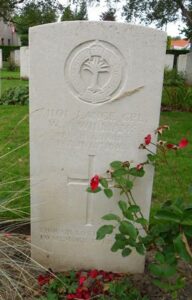Glamorgan Constabulary was formed in 1841 as the Home Office police force for the county of Glamorgan. It absorbed Neath Borough Police in 1947, and in 1969 amalgamated with Cardiff City Police, Swansea Borough Police and Merthyr Tydfil Borough Police to form South Wales Constabulary. The members of Glamorgan Constabulary who fell during the Great War are commemorated on two separate memorials: the main memorial being located in front of the South Wales Police Headquarters, Cowbridge Road, Bridgend, and a second memorial, in the form of an illuminated scroll, which is located within Cardiff Police Station. The former memorial was unveiled in its original location in Canton on 22 November 1925 by Lieutenant Colonel Sir Rhys Williams, Bart, DSO, KC. A large proportion of the men below served with the Welsh Guards, which makes their write-ups somewhat repetitive, but is necessary to tell each individuals story. The memorial is nowhere near the boundary with Carmarthenshire, but as several officers served in the western part of the county, and others are already on other memorials on this website, then I have thought it fitting to add it here.
The Great War, 1914-1918
James Robert Angus, MiD, Lieutenant Colonel, South Wales Borderers. James was born in Dumfries on 6 December 1871, the son of James Angus and Emma Angus (nee Hopkins). His father was a Sergeant Major with the 24th Regiment of Foot, South Wales Borderers, and had moved his family to Brecon whilst stationed in the Barracks. James had served with the Grenadier Guards during the Boer War of 1899-1901 and upon his return married Edith Prosser, the daughter of Alderman Prosser, of Treharris, in 1903. He had joined the Barry Constabulary in 1893 and by the outbreak of war was serving as a Police Inspector, No PS 310, at Abercynon, and was living with his wife at Vaynor House, Edwardsville. James was commissioned into the 16th Battalion, Welsh Regiment following its formation at Cardiff, and rose through the ranks, being promoted Lieutenant Colonel and being given command of the 11th Battalion, South Wales Borderers on 6 August 1917. Both his former and latter battalions served with 115 Brigade, 38th (Welsh) Division, and James took part in the brigade’s assault on Mametz Wood in July 1916. James commanded the 11th Battalion, South Wales Borderers with distinction during the famed assault of the 38th (Welsh) Division at Pilckem Ridge on 31 July 1917 and in the continued fighting there over the coming weeks until the division was withdrawn to a quieter sector on the Lys to rest and rebuild and for his work was mentioned in despatches by Sir Douglas Haig. On 17 September 1917 James decided to take a swim in the River Lys where it flows through the village of Erquinghem, and tragically drowned. The 45-year-old was buried by his men in grave II.F.8. in the nearby Erquinghem-Lys Churchyard Extension, France.
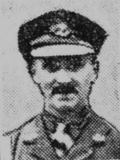
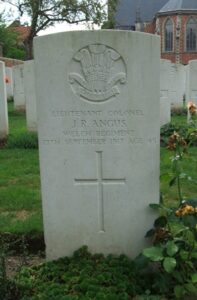
Edward Beresford, Sergeant, 14215, South Staffordshire Regiment. Edward was born in Netherton, Worcestershire in 1890. By 1911 he was serving as a policeman, PC 205, at Penarth, lodging with PC Charles Harrison at 44, High Street, Barry. He enlisted at Penarth at the outbreak of war, joining the 8th Battalion, South Staffordshire Regiment. The battalion formed at Lichfield in September 1914, moving to Wareham in 51 Brigade, 17th Division and finally to Winchester in June 1915 before landing at Boulogne on 14 July 1915. The division spent its initial period of trench familiarisation in the southern area of the Ypres salient and saw some heavy fighting at the Bluff during February 1916. In May 1916 the battalion moved out of the line and completed a training regime before the entire division began its move south to the Somme sector, reaching Cardonette, near Amiens, on 12 June 1916. On 28 June the battalion moved forwards to Heilly and by 00.35 on the morning of 1 July was at Morlancourt, in readiness for the main attack which was to be launched at Fricourt at 06.20. The division, fighting alongside the 7th Division, captured Fricourt, but suffered heavy casualties. By 10 July 1916, while the Welsh were storming Mametz Wood, the 8th South Staffs was in Quadrangle Trench when it came under heavy machine-gun fire from Contalmaison, and suffered over 200 casualties during another hard day fighting. Edward was 26 years old when he was killed during the day. He has no known grave and is commemorated on pier and face 7B of the Thiepval Memorial, France.
Richard William Brown, Acting Sergeant, 49106, Royal Welsh Fusiliers. Richard was the son of John and Ann Brown, of 3, Edwen Street, Newport, Mon. He served as a policeman, PC 52, at Barry prior to marrying Lilian Bishop there in 1913. Richard enlisted at Cardiff into the Royal Welsh Fusiliers. He was posted to France, joining the 17th Battalion, Royal Welsh Fusiliers, which was attached to 115 Brigade, 38th (Welsh) Division. Richard probably joined the battalion at Ypres in time to take part in the famous assault by the 38th (Welsh) Division on Pilckem Ridge on 31 July 1917. Following the successful capture of their objectives, the division remained in the area to take part in the ensuing Battle of Langemarck, before being moved to a more peaceful sector near Armentieres over the winter of 1917-18. As a result of the German spring offensive of 21 March 1918, which broke the British lines to the south, the division was one of a number moved south to bolster the defences and prevent a total break-through, taking up positions around Aveluy Wood, north of Albert by April 1918. Richards battalion suffered heavy casualties here during a successful advance on the Bouzincourt Ridge on 1 May, which gave the division a good viewpoint over the German positions on Thiepval Ridge, and from 21 August 1918 took part in the advance across the Ancre Valley, helping to capture Thiepval Ridge and Pozieres. The division then took part in the advance across the old Somme battlefields of 1916 towards the mighty Hindenburg Line. Richard was killed in action during the divisions successful assault on the Canal du Nord on 4 September 1917. The 30-year-old is buried in grave VII.C.7. in Sailly-Saillisel British Cemetery, France.
William Henry Carter, Guardsman, 1214, Welsh Guards. William was the son of Henry and Mary Carter, of 21, Hope Place, Paulton, Bristol. He served as a Policeman, PC 404, at Nantyfyllon prior to the war. William enlisted at Bridgend into the 1st Battalion, Welsh Guards. The Regiment was raised by Royal Warrant of 26 February 1915, at White City, before landing at Le Havre on 18 August 1915, becoming attached to 3rd Guards Brigade, Guards Division. The Division saw its first major action during the Battle of Loos on 25 September 1915. The Guards Division was in reserve for the first two days of the battle, before moving forwards on the night of 26-27 September to take part in an assault on Hill 70, a feature which overlooked Loos village. The attack was carried out during the night of 27 September, but saw the Welsh Guards driven back after suffering heavy casualties. After a few days rest the Welsh Guards went back into action slightly to the north, at the Hohenzollern Redoubt and remained here until being relieved on 27 October. Just prior to their relief William was wounded. He died of his wounds at No 4 Casualty Clearing Station on 25 October 1915, aged 21. He is buried in grave IV.D.21. in Lillers Communal Cemetery, France.
Albert John Channing, Corporal, 82346, Royal Engineers. Albert was the son of John and Elizabeth Channing, of 6, Everard Street, Barry Dock. He trained as a gas fitter and plumber at Barry Docks prior to becoming a policeman, PC 257, at Penrhiwceiber prior to the war. Albert enlisted at Cardiff into the Royal Engineers and was posted to the 124th Field Company, Royal Engineers, which was attached to the 38th (Welsh) Division. He landed in France with the division on 3 December 1915, and moved with it to the so-called Nursery Sector near Fleurbaix, for trench initiation alongside the 19th Division. The division moved south to the Somme in June 1916 in readiness to take part in its now famous assault on Mametz Wood, and by the end of the summer had moved to positions north of Ypres, at Boesinghe, where it remained until its successful capture of the Pilckem Ridge on 31 July 1917. After taking part in the subsequent Battle of Langemarck the division wintered in the Armentieres sector before moving to the Somme by April 1918, taking up positions along the Bouzincourt Ridge, near Aveluy Wood. Albert became ill whilst the division was in the Aveluy Wood sector and died of pneumonia at No 3 Casualty Clearing Station on 4 July 1918, aged 23. He is buried in grave III.C.18. in Bagneux British Cemetery, Gezaincourt, France.
Reginald Charles, Company Sergeant Major, 32501, Welsh Regiment. Reginald was the son of Frank and Elizabeth Charles, of Newport, Mon. He married Evelyn M. Hodges, of 14, Adare Street, Ogmore Vale, in 1915.He served as a Policeman, PC 715, at Maesteg prior to enlisting at Cardiff into the 16th Battalion, Welsh Regiment (Cardiff City). The battalion trained at Rhyl before moving to Winchester in the summer of 1915 attached to 115 Brigade, 38th (Welsh) Division and landed in France on 4 December 1915. The division moved to the so-called Nursery Sector near Fleurbaix, for trench initiation alongside the 19th Division and held the line at Cuinchy before moving south to the Somme in June 1916 in readiness to take part in its now famous assault on Mametz Wood. Reginald was fortunate to survive his battalions assault on Mametz Wood on 7 July 1916, which saw the battalion suffer heavily. The division had all but cleared the wood when its troops were relieved from its northern edge on 12 July and after a brief spell in the line at Hébuterne, moved to positions north of Ypres, at Boesinghe, where it remained until launching its successful assault on the Pilckem Ridge on 31 July 1917. Reginald was wounded during the battle, and was evacuated along the chain of casualty clearing stations to Abbeville, where he died of his wounds on 13 August 1917, aged 25. He is buried in grave III.B. 27. In Abbeville Communal Cemetery Extension, France.
Bertram Frederick Crees, Sapper, 13986, Royal Engineers. Bertram was the son of Frederick and Emily Crees, of East Brent, Highbridge, Somerset. He was a policeman in Somerset prior to marrying Winifred Pickford, at Cameley, Somerset on 23 April 1913, and then became a policeman, PC 251, at Tonmawr. He enlisted at Taunton into the Royal Engineers, and was posted to France on 17 August 1914 with the 17th Field Company, Royal Engineers, as part of the 5th Division of the British Expeditionary Force. Bertram would have taken part in the Battle of Mons and the subsequent retreat to the Marne, where the BEF fought two Battles, of the Marne and the Aisne, before moving to Flanders, and fought at the Battle of La Basseé, at Messines in October 1914, taking part in the capture of Hill 60, and the Second Battle of Ypres in April 1915. Bertram was killed in action during Second Ypres, on 30 April 1915, aged 30. He has no known grave and is commemorated on panel 9 of the Ypres (Menin Gate) Memorial, Belgium.
Joseph Patrick Deehan, Gunner, RMA/10001, Royal Marine Artillery. Joseph was born in Limerick on 17 March 1885. He enlisted into the Royal Marine Artillery on 3 April 1902, and served continuously until joining the Royal Fleet Reserve on 3 April 1914, after having completed 12 years’ service. He joined the Glamorgan Constabulary and served as a policeman, PC 270, at Llanishen prior to being mobilised on 2 August 1914. He landed at Ostend with the Royal Marine Artillery that month, and took part in the defence of Antwerp. Joseph then became posted to the RNAS Armoured Cars, attached to the Royal Flying Corps, until being posted to the RMA Anti-Aircraft Brigade. His health began to break down, and he was discharged as medically unfit, being hospitalised in Londonderry from 26 January 1916. He died of tuberculosis at 55, Dungavin Road, Londonderry, on 7 March 1916, aged 30. Joseph was not commemorated by the CWGC until being accepted for commemoration in January 2005. He has no known grave and is commemorated on the Addenda Panel of the Brookwood (United Kingdom 1914-1918) Memorial, Surrey.
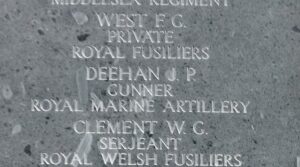
Arnold Dickens, Lance Corporal, 24186, Welsh Regiment. Arnold was the son of Joseph and Mary Jane Dickens, of 83 George Street Barry Dock. He worked as a fitters’ helper before becoming a Policeman, PC 273, at Oystermouth prior to the war. Arnold enlisted at Swansea into the Welsh Regiment, and was posted to the 19th Battalion, Welsh Regiment, which was the Pioneer Battalion to the 38th (Welsh) Division. He landed in France with the battalion on 5 December 1915 and moved with the division to the Nursery Sector near Fleurbaix, for trench initiation alongside the 19th Division. Arnold would have taken part in the Divisions famous assault on Mametz Wood in July 1916. The division was withdrawn from the Somme after a short spell in the line at Hébuterne and moved to positions north of Ypres, at Boesinghe at the end of the summer. The division spent the coming months preparing to launch an assault on the Pilckem Ridge, during the opening day of the Third Battle of Ypres, and spent months improving trenches and carrying out trench raids to familiarise themselves with the ground in front of them. On 26 June 1917 the 19th Welsh were at work in the trenches when a shell burst nearby, killing Arnold outright. The 24-year-old was buried by his comrades in grave II.H.6. of Bard Cottage Cemetery, Belgium. His parents had two other sons who served, one was badly wounded at Mons in 1914 and another was invalided due to ill health.
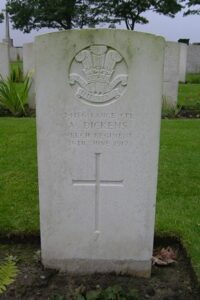
Michael Doyle, Private, 7793, Irish Guards. Michael was the son of Patrick and Kate Doyle, of Kilfane, Thomastown, Co. Kilkenny. He moved to south Wales to work as a Policeman, PC 203, at Caerau prior to the war. He travelled back to Ireland in August 1914 to enlist at Kilkenny into the Irish Guards and landed in France with the 2nd Battalion, Irish Guards on 16 August 1915. The battalion was attached to the 2nd Guards Brigade, Guards Division and moved into the Loos sector into reserve for the launching of the Battle of Loos on 25 September 1915. The 2nd Battalion, Irish Guards moved into their positions at Chalk Pit Wood on 27 September in order to attack a strong German position known as Bois Hugo, while to their right the 3rd Guards Brigade was to assault Hill 70, a position overlooking Loos village. The 2nd Battalion, Irish Guards attacked alongside the Scots Guards but were beaten off, suffering heavy casualties before being forced to withdraw back to their original starting positions. Michael was killed in action during this attack on 27 September 1915. The 25-year-old has no known grave and is commemorated on panel 9/10 of the Loos Memorial, France.
William East, Guardsman, 1330, Welsh Guards. William was the son of George and Jane East, of 31, South Street, Oldcastle. He served as a Policeman, PC 548, at Llanbradach and Caerphilly prior to the war. William enlisted into the Welsh Guards following its formation by Royal Warrant of 26 February 1915, at White City. The newly formed regiment had the honour of being on guard at Buckingham Palace on St David’s Day, 1915. The 1st Battalion, Welsh Guards landed at Le Havre on 18 August 1915, becoming attached to 3rd Guards Brigade, Guards Division. The Division saw its first major action during the Battle of Loos on 25 September 1915, seeing very heavy fighting around Hill 70. Following a brief rest period, the Welsh Guards moved back into the Loos front on 3 October, in the vicinity of the Hohenzollern Redoubt. For the first two days of this tour the men worked on linking up the old British trenches with the newly captured German trenches, and carrying gas cylinders to the front line. It was while carrying out this hazardous and unpleasant work that William was killed on 6 October 1915. The 28-year-old has no known grave and is commemorated on panel 10 of the Loos Memorial, France.
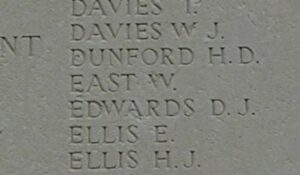
Edward John Edwards, Guardsman, 801, Welsh Guards. Edward was the son of David and Margaret Edwards, of 6 Olive Place, Trecynon, Aberdare. He served as a Policeman, PC 576, at Sketty prior to the war. Edward enlisted into the Welsh Guards at Swansea, following its formation by Royal Warrant of 26 February 1915. The newly formed regiment had the honour of being on guard at Buckingham Palace on St David’s Day, 1915. The 1st Battalion, Welsh Guards landed at Le Havre on 18 August 1915, becoming attached to 3rd Guards Brigade, Guards Division. The Division saw its first major action during the Battle of Loos on 25 September 1915, seeing very heavy fighting around Hill 70. The Guards Division wintered in the Ypres Salient before leaving for the Somme on 27 July 1916 in order to take part in the Somme offensive. On 9 September the Welsh Guards stood ready behind the 16th Division, which had been tasked with the capture of the village of Ginchy, ordered to take over the village once it had been captured. As the Welsh Guards advanced during the morning of 10 September they soon found that the village had not been cleared and their right flank was open to the enemy. The Germans took advantage of the situation and counter-attacked at dawn and fierce fighting raged throughout the day. Edward was killed in action at some time during this fighting on 10 September 1916. The 22-year-old has no known grave and is commemorated on pier and face 7D of the Thiepval Memorial, France.
David William Evans, Private, 1270, Welsh Guards. David was the son of David and Margaret Evans, of Pantyrhedyn, Caio. The family later moved to Caegwyn, Llanycrwys. David became a policeman, PC 648, at Caerau prior to the war and enlisted at Bridgend into the 1st Battalion, Welsh Guards, which had been formed by Royal Warrant on 26 February 1915. The battalion moved to France, landing at Le Havre on 18 August 1915, as part of 3rd Guards Brigade, Guards Division. The Division saw its first major action during the Battle of Loos on 25 September 1915. The Guards Division was in reserve for the first two days of the battle, before moving forwards on the night of 26-27 September to take part in an assault on Hill 70, a feature which overlooked Loos village. The attack was carried out during the night of 27 September, but saw the Welsh Guards driven back after suffering heavy casualties. David was killed at Hill 70 on 27 September 1915, aged 19. He has no known grave, and is commemorated on panel 10 of the Loos Memorial, France.
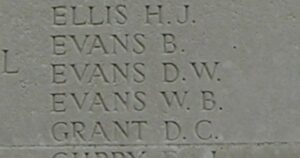
Edward Price Evans, Guardsman, 3704, Welsh Guards. Edward was born in Old Radnor in 1874, the son of George and Harriet Evans, of Church Cottage. He served as a Policeman, PC 477, at Risca by 1901, and was stationed at Tonypandy prior to the war. He enlisted at Tonypandy into the Welsh Guards and was posted to France, probably in August 1917 as a reinforcement to the 1st Battalion, Welsh Guards, which had suffered heavy losses during the assault on Pilckem Ridge, with the 3rd Guards Brigade, Guards Division. He would have taken part in further fighting at Ypres with the Welsh Guards, before the Guards Division was moved away from the sector to the Cambrai sector, in order to take part in a fresh offensive there. The Guards were initially held in reserve for the opening of the battle on 20 November 1917, and did not go into action until the battle had turned in favour of the Germans, who launched a series of counter-attacks which created a salient around the village of Flesquières. After taking part in heavy fighting around Gouzeaucourt, the Guards Division was moved out for a rest on 27 November. Three days later, the Germans broke through the British lines and the Guards were rushed forwards and recaptured Gouzeaucourt. Edward was wounded at some time during this German counter-attack and was invalided to No 5 General Hospital, Rouen, where he died of his wounds on 9 December 1917, aged 43. He is buried in grave P.V.M.18. in St. Sever Cemetery Extension, Rouen, France.
Henry George Evans, Sergeant, 26474, Royal Garrison Artillery. Henry was born on 18 March 1891, the son of George Thomas Evans and Francis Maine Evans, of Ashtead, Surrey. He had enlisted into the Royal Garrison Artillery on 23 March 1907 and served until transferring to the Army Reserve on 2 December 1912, becoming a policeman, PC 679, at Tonypandy. He re-enlisted into the Royal Garrison Artillery on 5 August 1914 and embarked for France to join the 120th Heavy Battery, Royal Garrison Artillery on 24 March 1916. Henry suffered several spells of sick while in France and was eventually invalided home on 26 April 1917, to be posted to No. 3 R.A. Training Depot. Henry married Isabella Villaume on 16 July 1917. He died of bronchial pneumonia at the University War Hospital at Southampton on 10 March 1919, aged 27, and is buried in grave A. 1187 in Melcombe Regis Cemetery, England.
John Evans, Guardsman, 6031, Irish Guards. John was the son of Edward William and Mary Ann Evans, of 22 Thompson Villas, Llanwonno. He served as a Policeman, PC 704, at Llandaff North prior to the war. He enlisted at Llanwonno into the Irish Guards and landed in France on 1 April 1915, joining the 1st Battalion, Irish Guards. John saw his first major action during the Second Battle of Ypres, and in September fought with the battalion following its transfer to the Guards Division at the Battle of Loos. He was wounded during the divisions assault on Cuinchy during the Somme offensive the following year and was invalided home, receiving treatment at Darwen Hospital before coming home on leave. Following his recovery, he was sent back to France in the summer of 1917, joining the 2nd Battalion, Irish Guards, which was attached to the 2nd Guards Brigade, Guards Division. His leadership qualities were noted during the attack of the Guards Division on the Pilckem Ridge on 31 July 1917, and he was offered a commission as an officer. Before he had a chance to leave the battalion to take up the offer, it was on its way south to the Cambrai sector, in order to take part in a fresh offensive there. The Guards were initially held in reserve for the opening of the battle on 20 November 1917, and did not go into action until the battle had turned in favour of the Germans, who launched a series of counter-attacks which created a salient around the village of Flesquières. After taking part in heavy fighting around Gouzeaucourt, the Guards Division was moved out for a rest on 27 November. John was killed in action on the day the battalion was relieved in the line, on 27 November 1917, aged 28, just days before he was due to return home for officer training. He has no known grave and is commemorated on panel 2/3 of the Cambrai Memorial, Louverval, France.
Ronald Evans, Guardsman, 2961, Welsh Guards. Ronald was the son of James Herbert Evans and Mary Jane Evans, of 35 Egerton Street, Cardiff. He served as a Policeman, PC 578, at Barry Dock prior to the war. He enlisted at Barry into the Welsh Guards and was posted to France to the 1st Battalion, Welsh Guards, probably in 1916 as a reinforcement to the battalion following its heavy losses on the Somme. The battalion was attached to the 3rd Guards Brigade, Guards Division and wintered in the Somme sector. In March 1917 the division took part in the advance caused by the German Retreat to the Hindenburg Line. Later that year it moved north to Ypres, and took part in the Battle of the Pilckem Ridge on 31 July 1917. He would have taken part in further fighting at Ypres with the Welsh Guards, before the Guards Division was moved away from the sector to the Cambrai sector, in order to take part in a fresh offensive there. The Guards were initially held in reserve for the opening of the battle on 20 November 1917, and did not go into action until the battle had turned in favour of the Germans, who launched a series of counter-attacks which created a salient around the village of Flesquières. After taking part in heavy fighting around Gouzeaucourt, the Guards Division was moved out for a rest on 27 November. Three days later, the Germans broke through the British lines and the Guards were rushed forwards and recaptured Gouzeaucourt. Ronald was killed in action near Gouzeaucourt on 1 December 1917, aged 19. He has no known grave and is commemorated on panel 3 of the Cambrai Memorial, Louverval, France.
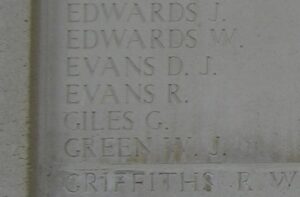
John Farley, Lance Corporal, 719, Welsh Guards. John was the son of Cornelius and Kate Farley, of Cork Street, Kinsale, Ireland. He came to south Wales to serve as a Policeman, PC 270, at Penrhiwceiber prior to the war. John enlisted into the Welsh Guards at Aberdare following its formation by Royal Warrant of 26 February 1915. The newly formed regiment had the honour of being on guard at Buckingham Palace on St David’s Day, 1915. The 1st Battalion, Welsh Guards landed at Le Havre on 18 August 1915, becoming attached to 3rd Guards Brigade, Guards Division. The Division saw its first major action during the Battle of Loos on 25 September 1915, seeing very heavy fighting around Hill 70 on the 27th. The Guards Division wintered in the Ypres Salient before leaving for the Somme on 27 July 1916 in order to take part in the Somme offensive. On 9 September the Welsh Guards stood ready behind the 16th Division, which had been tasked with the capture of the village of Ginchy, ordered to take over the village once it had been captured. As the Welsh Guards advanced during the morning of 10 September they soon found that the village had not been cleared and their right flank was open to the enemy. The Germans took advantage of the situation and counter-attacked at dawn and fierce fighting raged throughout the day. The battalion was relieved on the following day and after a brief rest in billets moved back forwards on 14 September in order to take part in the next phase of the attack, against the line of Flers, Morval, and Lesboeufs. At dawn on 16 September the Welsh Guards attacked again, supported for the first time by tanks. Heavy rain blunted the attack which stalled some 100 yards short, with heavy losses among the battalion. John was mortally wounded during the attack and died that same day, on 16 September 1916, aged 24. He has no known grave and is commemorated on pier and face 7D of the Thiepval Memorial, France.
Edward Findlay, Lance Sergeant, 43691, Bedfordshire Regiment. Edward was the son of Andrew and Isabella Shand Findlay. He resided at Scethrog Post Office, Bwlch, Breconshire in 1911, before becoming a Policeman, PC 558, at Aberdare prior to the war. He enlisted into the 9th Battalion, South Wales Borderers, which was a training battalion, and served with the Army Service Corps before joining the 4th Battalion, Bedfordshire Regiment. The battalion had landed in France on 25 July 1916 and joined 190 Brigade, 63rd (Royal Naval) Division. The division saw heavy fighting on the Somme later that year, taking part in the horrendous fighting in the Ancre Valley. In April 1917 the Division was at Arras, and fought at the Second Battle of the Scarpe, where it captured Gavrelle. The division then fought at the Battle of Arleux, before moving north to Ypres, where it took part in the Second Battle of Passchendaele. Its next major action was at Cambrai, during the Action of Welch Ridge, and it was still in the area when the Germans launched their Spring Offensive on 21 March 1918. The division fought a brave rear-guard action over the coming days but by 26 March had been forced back onto the Thiepval Ridge. After a brief rest period the 4th Bedford’s moved back into the line on 6 April and helped beat off an enemy attack. The line had by now settled, with the Germans switching their focus to a new assault to the north, in the Lys sector, and the Royal Naval Division settled into another period of routine trench warfare. On the night of 24/25 May 1918 the battalion launched a large-scale trench raid on the German lines at Q.25.a.b., and suffered the death of a number of officers and men. Edward was posted as missing believed killed in action during the raid, on 25 May 1918. The 34-year-old has no known grave and is commemorated on panel 28-29 of the Pozieres Memorial, France.
Sidney William Goodliffe, Lance Corporal, 8535, Welsh Regiment. Sidney was the son of Sergeant Major Josiah Edward Goodliffe and Sarah Ann Goodliffe, of 26, Newfoundland Road, Heath, Cardiff. He had served with the Welsh Regiment prior to being placed on the Army Reserve and upon leaving the army served as a Policeman, PC 691, at Ton Pentre prior to the war. He re-enlisted at Cardiff and was posted to France with the 2nd Battalion, Welsh Regiment in August 1914 and took part in the epic retreat from Mons to the Marne. He was wounded during the famous assault by the 2nd Welsh on Chivy Ridge, during the Battle of the Aisne, on 26 September 1914. Following a brief spell in hospital, he returned to action with the 2nd Welsh at Ypres, and took part in the epic fighting along the Menin Road, during the defence of Gheluveld on 31 October 1914. An epic stand by the 2nd Welsh, 1st SWB and the Worcester Regiment prevented an enemy break-through which most likely would have won them the war. Heavy fighting continued over the coming days, but the line of the BEF held. Sidney was killed in action on 12 November 1914 when he was shot in the head during a final attempt by the Germans to break-through the lines around Nonne Boschen. The 28-year-old has no known grave and is commemorated on panel 37 of the Ypres (Menin Gate) Memorial, Belgium.
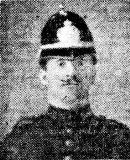
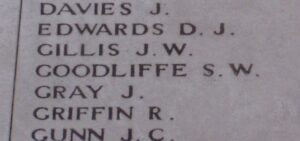
David Charles Grant, Guardsman, 1331, Welsh Guards. David was the son of William Thomas and Emily Grant, of 66, High Street, Barry. He served as a Policeman, PC 591, at Porthcawl and at Llantwit Major prior to the war. David enlisted at Bridgend into the 1st Battalion, Welsh Guards, which had been formed by Royal Warrant on 26 February 1915. The battalion moved to France, landing at Le Havre on 18 August 1915, as part of 3rd Guards Brigade, Guards Division. The Division saw its first major action during the Battle of Loos on 25 September 1915. The Guards Division was in reserve for the first two days of the battle, before moving forwards on the night of 26-27 September to take part in an assault on Hill 70, a feature which overlooked Loos village. The attack was carried out during the night of 27 September, but saw the Welsh Guards driven back after suffering heavy casualties from machine-gun fire. David was killed in action during the attack that day. The 26-year-old has no known grave and is commemorated on panel 10 of the Loos Memorial, France.
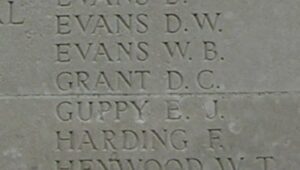
John Alfred Griffiths, Sergeant, 17945, Welsh Regiment. John was born in 1889, the son of William and Mary Griffiths. William died within months of Johns birth, and the family had until then lived in Swansea. Mary returned to live with her mother at Walwyn’s Castle following the death of her husband and married George Bailey Richards, of 5, Fleet Street, Pennar in about 1890. John was raised at Pennar, and worked as a Policeman, PC 533, at Mumbles prior to the war. He enlisted there into the 14th Battalion, Welsh Regiment, which was known as the Swansea Pals. The Battalion was raised at Swansea by the Mayor and Corporation with the Swansea Football and Cricket Club, and moved to Rhyl in 129 Brigade, 43rd Division. After training, the Division moved to Winchester, where the formation became 114 Brigade, 38th (Welsh) Division, and in December 1915 landed at Le Havre. The Division moved to positions in the so-called Nursery Sector near Fleurbaix, and received instruction in trench warfare from the Guards and 19th Divisions. It moved to positions on the La Basseé Canal in the spring of 1916. The 14th Welsh were in the front-line trenches at Givenchy when John was killed, on 13 March 1916, aged 27. He is buried at Guards Cemetery, Windy Corner, Cuinchy, France, in grave III.M.12.

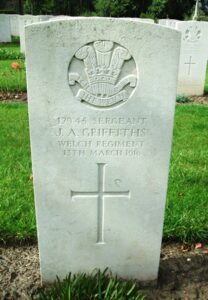
George Robert Guy, Private, 22592, Grenadier Guards. George was the son of George and Sarah Ann Guy, of 24, Plassey Street, Penarth. He worked as an undertakers’ assistant prior to serving as a Policeman, PC 629, at Tonypandy prior to the war. George enlisted at Cardiff into the Grenadier Guards in February 1915 and landed in France on 6 November 1915, joining their 2nd Battalion, which had been withdrawn from the Loos sector, along with the remainder of the Guards Division, and taken up positions in the Ypres Salient. By the end of July 1916, the division had left the Salient and began making its way down to the Somme sector, in order to take part in the great offensive there. By 9 September the Guards Division stood ready behind the 16th Division, which had been tasked with the capture of the village of Ginchy, ordered to take over the village once it had been captured. As the Guards advanced during the morning of 10 September they soon found that the village had not been cleared and their right flank was open to the enemy. The Germans took advantage of the situation and counter-attacked at dawn and fierce fighting raged throughout the day. The battalion was relieved on the following day and after a brief rest in billets moved back forwards on 14 September in order to take part in the next phase of the attack, against the line of Flers, Morval, and Lesboeufs. On 15 September the 2nd Battalion, Grenadier Guards took part in an assault on the village of Lesboeufs, but were beaten off, suffering heavy casualties. George was killed that day, on 15 September 1916, aged 26. He has no known grave and is commemorated on pier and face 8D on the Thiepval Memorial, France.
Richard Hamer, Lance Corporal, 1672, Welsh Guards. Richard was the son of Hugh and Margaret Hamer, of 4, Abernant Road, Abernant, Aberdare. He worked as a coal hewer prior to becoming as a Policeman, PC 363, at Skewen prior to the war. He enlisted in June 1915 into the 1st Battalion, Welsh Guards at Aberdare following its formation by Royal Warrant of 26 February 1915. The newly formed regiment had the honour of being on guard at Buckingham Palace on St David’s Day, 1915. The 1st Battalion, Welsh Guards landed at Le Havre on 18 August 1915, becoming attached to 3rd Guards Brigade, Guards Division. The Division saw its first major action during the Battle of Loos on 25 September 1915, seeing very heavy fighting around Hill 70 on the 27th. The Guards Division wintered in the Ypres Salient before leaving for the Somme on 27 July 1916 in order to take part in the Somme offensive. Richard was wounded just prior to the Welsh Guards coming out of the line at Ypres. He was evacuated to the 2nd Canadian Hospital at Boulogne where he died of his wounds on 12 July 1916, aged 24. Richard is buried in grave VIII.D.110. in Boulogne Eastern Cemetery, France. His elder brother Caleb Hamer was killed at Gallipoli on 25 May 1915 while serving with the South Wales Borderers.
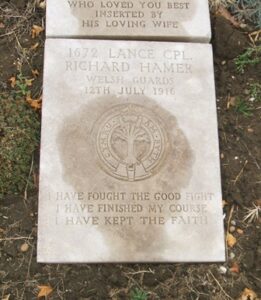
William Hammond, Private, 12732, Grenadier Guards. William was the son of John and Sarah Hammond, of 62 Frog Lane, Lichfield, Staffs. He had served with the Grenadier Guards prior to becoming a Policeman, PC 239, at Penygraig and Blaenclydach prior to the war. He re-enlisted into the Grenadier Guards at Rugeley and landed in France on 13 August 1914 with the 2nd Battalion, Grenadier Guards, taking part in the Battle of Mons and the subsequent retreat to the Marne. Following the successful assault by the BEF at the Battles of the Marne and Aisne, which stopped the German drive on Paris, the BEF was posted north, to Flanders up to the north west of Ypres, to guard against a German drive towards the channel coast. William fought there throughout the first Battle of Ypres, but was wounded in the head on Christmas Day and invalided home. Upon recovering from his wounds, he was posted to France with the 3rd Battalion, Grenadier Guards, which was attached to the 2nd Guards Brigade, Guards Division in the Loos sector, preparing to take part in the forthcoming Battle of Loos. The division was in reserve for the initial attacks on 25 September 1915, and did not go into action until assaulting Hill 70 and Bois Hugo on 27 September. Heavy fighting continued at Loos over the coming weeks. On 15 October the 3rd Grenadier Guards returned to the front line opposite Big Willie Trench after a spell in reserve, and on 17 October 1915 came under heavy shell-fire whilst working on trench repairs. William was among a number of men killed during the bombardment that day. The 32-year-old has no known grave and is commemorated on panels 5-7 of the Loos Memorial, France.
Augustus Harris, Lance Corporal, 1184, Welsh Guards. Augustus was the son of Thomas and Elizabeth Harris, of 13, Standard Street, Trethomas, Newport, Mon. He worked as a tinplate catcher prior to becoming a Policeman, PC 526, at Barry Dock prior to the war. Augustus enlisted at Cardiff into the 1st Battalion, Welsh Guards following its formation by Royal Warrant of 26 February 1915. The newly formed regiment had the honour of being on guard at Buckingham Palace on St David’s Day, 1915. The 1st Battalion, Welsh Guards landed at Le Havre on 18 August 1915, becoming attached to 3rd Guards Brigade, Guards Division. The Division saw its first major action during the Battle of Loos on 25 September 1915, seeing very heavy fighting around Hill 70 on the 27th. The Guards Division wintered in the Ypres Salient before leaving for the Somme on 27 July 1916 in order to take part in the Somme offensive. On 9 September the Welsh Guards stood ready behind the 16th Division, which had been tasked with the capture of the village of Ginchy, ordered to take over the village once it had been captured. As the Welsh Guards advanced during the morning of 10 September they soon found that the village had not been cleared and their right flank was open to the enemy. The Germans took advantage of the situation and counter-attacked at dawn and fierce fighting raged throughout the day. The battalion was relieved on the following day and after a brief rest in billets moved back forwards on 14 September in order to take part in the next phase of the attack, against the line of Flers, Morval, and Lesboeufs. At dawn on 16 September the Welsh Guards attacked again, supported for the first time by tanks. Heavy rain blunted the attack which stalled some 100 yards short, with heavy losses among the battalion. Augustus was among those killed during the attack of 16 September 1915. The 23-year-old has no known grave and is commemorated on pier and face 7D of the Thiepval Memorial, France. Some weeks after his death his wristwatch was found on the battlefield by an officer of the RFA and sent to Cardiff Police Station, from where it was claimed by his mother.
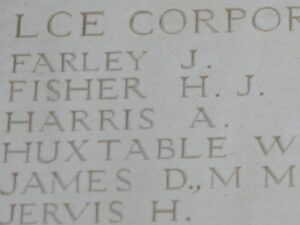
Robert John Harris, Sergeant, 23140, Welsh Regiment. Robert was the son of John and Martha Harris, of Llechwen Farm, Ynysybwl, Pontypridd. He served as a Policeman, PC 122, at Aberkenfig prior to the war. Robert enlisted at Bridgend into the 16th Battalion, Welsh Regiment (Cardiff City) and trained with the battalion at Rhyl and Winchester before it moved to France on 4 December 1915 attached to 115 Brigade, 38th (Welsh) Division. The division moved to the so-called Nursery Sector near Fleurbaix, for trench initiation alongside the 19th Division and held the line at Cuinchy before moving south to the Somme in June 1916 in readiness to take part in its now famous assault on Mametz Wood. The division was ordered to attack the wood on a single brigade front, using two battalions for the assault with a third in reserve, and General Ivor Philipps ordered his 115 Brigade to take up the challenge. The 11th SWB and the 16th Welsh were the two battalions ordered to make the assault, with the 16th Welsh on the right. At 8.30am on 7 July 1916 the two battalions attacked, but the 16th Welsh especially, came under heavy machine-gun fire from the Hammerhead and Flatiron Copse, due to the lack of smoke cover. No real gains had been made by the afternoon, so the 10th SWB was ordered forwards to join the attack, but by the end of the day the brigade was forced to withdraw after suffering severe casualties. Robert was among those killed in Mametz Wood on 7 July 1916. The 29-year-old has no known grave and is commemorated on pier and face 7A and 10A of the Thiepval Memorial, France.

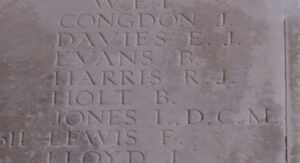
Arthur Hopkins, Private, 202671, Royal Welsh Fusiliers. Arthur was the son of Thomas and Elizabeth Hopkins, of Mill Farm, Michaelstone-le-Pit, Dinas Powis, Cardiff. He was a carpenter’s apprentice prior to becoming a Policeman, PC 609, at Melincrythan prior to the war. Arthur enlisted at Swansea into the Welsh Regiment, and was posted to the 19th Battalion, Royal Welsh Fusiliers. The battalion landed in France in June 1916 attached to 119 Brigade, 40th (Bantam) Division, and moved to the front near Loos. Late in 1916 they moved south to the Somme, and fought at the Battle of the Ancre, and remained in the area over the winter. In March 1917 the Germans withdrew to their shortened line, called the Hindenburg Line, and the 40th Division were one of the Divisions that followed the withdrawal. Later in the year they took part in the Battle of Cambrai, tasked with the attack on Bourlon Wood. On the morning of 23 November 1917, the division sent in 119 Brigade to attack German positions in Bourlon Wood, supported by a number of tanks. The 12th SWB and the 19th RWF led the assault, with the latter attacking along the road which runs northwards through the wood. The 19th RWF came under attack from the eastern edge of the wood and called for assistance, so two platoons of the 17th Welsh were sent to their assistance. Heavy fighting raged on in the wood throughout the day, and the division suffered terribly. Arthur was among those killed in Bourlon Wood on 23 November 1917. The 24-year-old has no known grave and is commemorated on panel 5 of the Cambrai Memorial, Louverval, France.
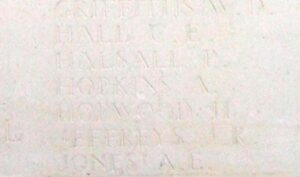
Charles Llewellyn James, Second Lieutenant, Welsh Regiment. Charles was the son of William and Barbara James, of St. Nicholas, Glamorgan. His father originally from Ciffig, near Whitland, was also a policeman. Charles served as a Policeman, PC 530, at Bridgend prior to the war. He originally enlisted into the Dragoon Guards, entering war with them on 18 May 1915. He was commissioned Second Lieutenant into the 18th Welsh on 26 June 1917 and had been attached to the 15th Welsh by 1918, joining the battalion on the Somme. Charles was killed in action during the raid an abortive raid by the 15th Welsh on Aveluy Wood on 10 May 1918, when the battalion came under shellfire by their own artillery barrage, which had fallen short. The 27-year-old is buried in grave I.E.4. in Martinsart British Cemetery, France.
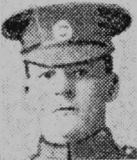
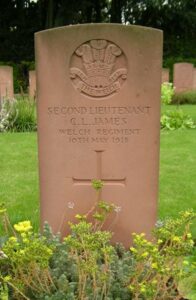
Ernest Thomas Jones, Private, 43723, Royal Berkshire Regiment. Ernest was the son of Thomas and Margaret Jones, of 20, Pentwyn Avenue, Penrhiwceiber. He served as a Policeman, PC 617, at Aberdare prior to the war. Ernest originally enlisted into the Army Service Corps, but was transferred to the 8th Battalion, Royal Berkshire Regiment, which was in France attached to 1 Brigade, 1st Division. On 2 February 1918 the battalion transferred to 53 Brigade, 18th (Eastern) Division, which was stationed south of the Somme, and was one of the Divisions hit there by the German Spring Offensive, which was launched on 21 March 1918. The division suffered terrible casualties during its withdrawal back to the Villers-Bretonneux area. On 8 August 1918 the 18th Division formed part of the force which attacked the German positions around Villers-Bretonneux, south of the Somme Valley, during the Battle of Amiens, and then took part in the great push by the Allies which ultimately ended the war. By 20 September 1918 the division was in the Ronssoy area, taking part in the Battle of Épehy, which was the second phase of the Battles of the Hindenburg Line. Ernest was killed in action near Ronssoy on 20 September 1918, aged 29. He has no known grave and is commemorated on panel 7 of the Vis-en-Artois Memorial, Haucourt, France.
Evan Jones, Sergeant, 34478, Welsh Regiment. Evan was the son of David and Sarah Jones, of 42, Ceridwen Street, Mountain Ash. He served as a Sergeant, PC 627, at Abercynon prior to the war. Evan enlisted at Mountain Ash into the Welsh Regiment, and was posted to the 10th Battalion, Welsh Regiment (1st Rhondda), which was training in Rhyl attached to 114 Brigade, 38th (Welsh) Division. Evan landed in France on 15 December 1915, over ten days after the battalion landed in France, and joined them in the Fleurbaix sector, where the division was being initiated into trench warfare alongside the 19th (Western) Division. Following several months spent holding the line in various locations from Fleurbaix down to Cuinchy, in June 1916 the 38th Division began its march south, in order to take part in the Somme offensive. It attacked Mametz Wood, firstly on 7 July, then again from 10 July, and after clearing the bulk of the wood moved via Hébuterne to Flanders then to positions north of Ypres, around Boesinghe. The division spent the coming months consolidating and improving trenches and familiarising with the ground in front of it, the Pilckem Ridge, which it was destined to assault during the forthcoming Third Battle of Ypres. On 30 May 1917, some three months before the launching of the battle, the 10th Welsh had working parties in the front line along the canal bank, digging and wiring a new communication trench south of the Pilckem Road. Evan was at work here that day when he was shot by a German sniper. He was carried back to a nearby dressing station and died of his wounds that same day, on 30 May 1917, aged 26. Evan is buried in grave II.A.11. in Bard Cottage Cemetery, Belgium.
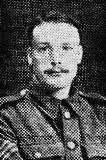
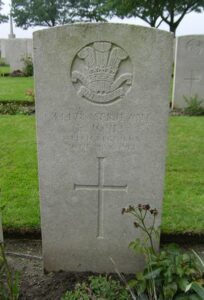
Henry Morgan Jones, Private, 1380, Welsh Guards. Henry was born at Llanbadarn in 1890, the son of Mary Jones. Mary married William Walter Hughes in 1899, and the family lived at Tancoed, Chancery, Llanfarian. Henry served as a Policeman, PC 117, at Bridgend prior to the war. He enlisted at Bridgend into the 1st Battalion, Welsh Guards, which had been raised by Royal Warrant of 26 February 1915, at White City. On 18 August 1915 the Welsh Guards landed at Havre, joining the 3rd Guards Brigade, Guards Division, and saw their first action at the Battle of Loos, attacking Hill 70 on 27 September, the third day of the battle. The Guards Division wintered in the Ypres Salient before leaving for the Somme on 27 July 1916 in order to take part in the Somme offensive. On 9 September the Welsh Guards stood ready behind the 16th Division, which had been tasked with the capture of the village of Ginchy, ordered to take over the village once it had been captured. As the Welsh Guards advanced during the morning of 10 September they soon found that the village had not been cleared and their right flank was open to the enemy. The Germans took advantage of the situation and counter-attacked at dawn and fierce fighting raged throughout the day. Henry was killed in action at some time during this fighting on 10 September 1916. The 26-year-old is buried in grave 9.E.22. in London Cemetery and Extension, Longueval, France.
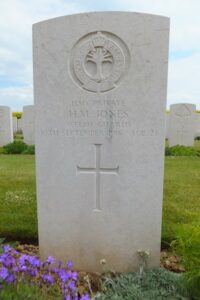
William Jones, MM, Private, 1189, Welsh Guards. William was the son of David and Hannah Jones, of Pantyffyllon, Llangeler. He worked on his parent’s farm before enlisting into the Glamorgan Constabulary and served as a Policeman, PC 684, at Maesteg prior to the war. He enlisted at Bridgend into the 1st Battalion, Welsh Guards, which had been raised by Royal Warrant on 26 February 1915. On 18 August 1915 the Welsh Guards landed at Havre, joining the 3rd Guards Brigade, Guards Division, and saw their first action at the Battle of Loos, attacking Hill 70 on 27 September, the third day of the battle. The Guards Division wintered in the Ypres Salient before leaving for the Somme on 27 July 1916 in order to take part in the Somme offensive. On 9 September the Welsh Guards stood ready behind the 16th Division, which had been tasked with the capture of the village of Ginchy, ordered to take over the village once it had been captured. As the Welsh Guards advanced during the morning of 10 September they soon found that the village had not been cleared and their right flank was open to the enemy. The Germans took advantage of the situation and counter-attacked at dawn and fierce fighting raged throughout the day. William was killed in action at some time during this fighting on 10 September 1916. He was 30 years old and is commemorated on pier and face 7D of the Thiepval Memorial, France. He was the holder of the Military Medal, the award of which was published in the London Gazette of 8 August 1916.
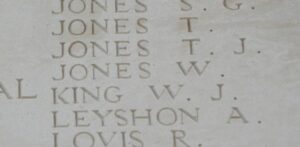
George Wilfred Lloyd, Gunner, 180347, Royal Garrison Artillery. George was born in 1894, the son of James Owen Lloyd and Mary Ann Lloyd (nee Jones), of Cilgarenydd, Pontfaen, Breconshire. He served as a Policeman, PC 223, at Mountain Ash prior to the war. George enlisted at Cardiff into the Royal Garrison Artillery and married Elizabeth Ann Clark, of Westwood House, Llanwonno Road, Mountain Ash, prior to embarking for France, probably on 10 September 1917, with the 381st Siege Battery, Royal Garrison Artillery. The battery joined 22nd Heavy Artillery Group (HAG) on 25 Sept 17 and served with several other HAG’s before becoming Army troops in June 1918. George was stationed with the battery near Loos, south of Bethune, when he was killed in action on 11 June 1918. The 23-year-old is buried in grave II.G.8. in Houchin British Cemetery, France.
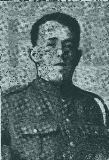
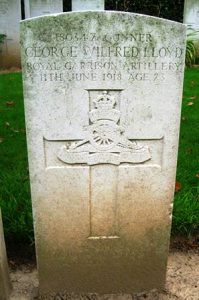
Frederick Charles Lord, Corporal, 20673, Grenadier Guards. Frederick was born on 10 July 1891, the son of Henry John and Maria Lord, of Stibbard, Guist, Norfolk. He served as a policeman, PC 634, at Cowbridge prior to enlisting at Cardiff into the Grenadier Guards. Frederick landed in France on 5 October 1915, and was posted to the 4th Battalion, Grenadier Guards, which was in the Loos sector, attached to the 3rd Guards Brigade, Guards Division. Frederick would have taken part in fighting around the Hohenzollern Redoubt with the battalion, before it was withdrawn from the Loos sector, along with the remainder of the Guards Division, and taken up positions in the Ypres Salient. By the end of July 1916, the division had left the Salient and began making its way down to the Somme sector, in order to take part in the great offensive there. By 9 September the Guards Division stood ready behind the 16th Division, which had been tasked with the capture of the village of Ginchy, ordered to take over the village once it had been captured. As the 2nd Guards Brigade advanced during the morning of 10 September they soon found that the village had not been cleared and their right flank was open to the enemy. The Germans took advantage of the situation and counter-attacked at dawn and fierce fighting raged throughout the day. The 4th Grenadiers held a position behind the 2nd Guards Brigade throughout the day and on the following morning moved into the front line in readiness to attack the German position known as the Quadrilateral. The attack failed and on 12 September the battalion was relieved. Frederick was wounded at Ginchy and was evacuated to a casualty clearing station at Corbie where he died on 14 September 1916, aged 25. He is buried in grave 2.C.91. in Corbie Communal Cemetery Extension, France.
William Henry Loud, Sergeant, 23311, Welsh Regiment. William was born in Worle, Somerset the son of Robert and Ellen Loud. The family moved to 28 Tallis Street, Cwmparc, Treorchy when he was young. He worked as a coal hewer before becoming a Policeman, PC 766, at Maesteg prior to the war. William enlisted at Bridgend into the 10th Battalion, Welsh Regiment (1st Rhondda), which trained at Rhyl and Winchester, attached to 114 Brigade, 38th (Welsh) Division. He landed in France after the main battalion, possibly among its first batch of reinforcements early in 1916, and probably joined up with it in the Cuinchy sector. During June the 38th Division marched southwards in order to take part in the great Somme offensive, which was launched on 1 July 1916. After a period of training the division moved along the Somme valley before relieving the 7th Division south of Mametz Wood. On 7 July the division launched its first assault on the wood, sending in the 11th SWB and 16th Welsh of 115 Brigade. Heavy machine-gun fire decimated the two battalions who were reinforced by the 10th SWB, but this initial attack was doomed to failure because of inadequate artillery support and lack of smoke screen. Following the sacking of the divisional commander, Sir Ivor Philipps, a new plan of attack was laid out and on 10 July the division attacked again with four battalions on a wider front. Early in the morning the 14th RWF, 16th RWF, 13th Welsh and 14th Welsh advanced and attacked the wood from the south, crossing Death Valley under heavy machine-gun fire. The 10th Welsh got involved at 4.30am, but came under heavy fire from the Hammerhead and met with heavy casualties. Fighting raged throughout the day and continued until the division was relieved on the 12th. William was killed in action during the initial assault of the 10th Welsh on 10 July 1916. He 22-year-old has no known grave and is commemorated on pier and face 7A and 10A of the Thiepval Memorial, France.
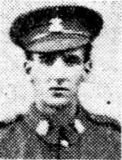
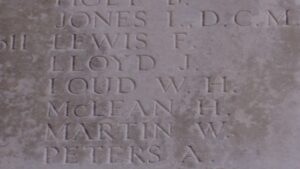
William George Mathias, Guardsman, 1210, Welsh Guards. William was born at Letterston in 1885, the son of John and Sarah Mathias. The family moved to Gilshave, Fishguard prior to the war. William served as a Policeman, PC 397, at Bridgend prior to the war. He enlisted at Bridgend into the 1st Battalion, Welsh Guards. The battalion had been formed after the Royal Warrant of 26 February 1915, and mounted its first guard at Buckingham Palace on St David’s Day, 1915. The battalion was to embark for France during the summer to join the 3rd Guards Brigade, Guards Division and would see its first major action during the Battle of Loos in September 1915. William, however, did not make it to France, as he became ill and died of pneumonia at Caterham Military Hospital, Surrey on 20 May 1915, aged 30. He is buried in Fishguard (Hermon) Baptist Burial Ground.
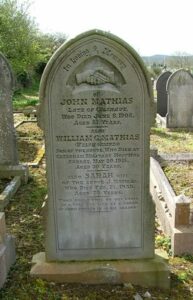
Leonard Nowell, Guardsman, 120, Welsh Guards. Leonard was the son of Ernest and Eliza Nowell, of Bridgwater, Somerset. By 1911 he was serving with the Grenadier Guards, and left to become a Policeman, PC 255, at Treharris prior to the war. Following the outbreak of war Leonard re-enlisted at Cardiff into the Grenadier Guards, with the regimental number 15067, and served with the BEF in France from 13 August 1914, before transferring to the Welsh Guards following its formation by Royal Warrant of 26 February 1915. The battalion landed at Le Havre on 18 August 1915, becoming attached to 3rd Guards Brigade, Guards Division. The Division saw its first major action during the Battle of Loos on 25 September 1915. The Guards Division was in reserve for the first two days of the battle, before moving forwards on the night of 26-27 September to take part in an assault on Hill 70, a feature which overlooked Loos village. The attack was carried out during the night of 27 September, but saw the Welsh Guards driven back after suffering heavy casualties. After a few days rest the Welsh Guards went back into action slightly to the north, at the Hohenzollern Redoubt. Leonard was serving as a servant to Lieutenant Wells when he was badly wounded at Vermelles on 12 October 1915 when three German shells crashed into the area occupied by the battalion transport section. He was rushed to No 2 Field Ambulance, where he died of his wounds that same day, on 12 October 1915, aged 22. Leonard is buried in grave I.L.18. in Vermelles British Cemetery, France.
Thomas O’Connor, Private, 5347, Irish Guards. Thomas was from Tralee, Co Kerry. He lived at Ystalyfera prior to the war, and married Catherine Bowen, of Lower Cwmtwrch, in the summer of 1910. Thomas had served as a Policeman at Ystalyfera under Sergeant Bowen, for several years prior to leaving the force to work at the Phoenix Tinplate Works. He enlisted into the Irish Guards soon after the outbreak of war and on 23 November 1914 was posted to France, joining the 1st Battalion, Irish Guards, which was attached to the 4th (Guards) Brigade, 2nd Division. The battalion had suffered heavily during the early months of the war, especially during the defence of Klein Zillebeke. In May 1915, the 1st Irish Guards took part in the Battle of Festubert, and on 20 August 1915 transferred to the 1st Guards Brigade, Guards Division, taking part in the Battle of Loos in September 1915. After wintering in the Ypres Salient, the division left for the Somme on 27 July 1916 in order to take part in the Somme offensive and saw heavy fighting at Ginchy, Flers-Courcelette and at Morval. The Guards Division remained in the Somme sector over the winter of 1916-17 and followed the German withdrawal to the Hindenburg Line the following year, before being transferred back to the Ypres Salient, taking the line north of the 38th (Welsh) Division along the Yser Canal. On 28 June 1917 the battalion was in the trenches near Boesinghe, when Thomas became wounded. He was walking back to the dressing station when he was struck by a shell fragment which killed him. The 37-year-old is buried in grave 3.F.24. in Ferme Olivier Cemetery, Ieper, Belgium. Thomas is not commemorated on the Glamorgan Constabulary War Memorial, but on the war memorial at Ystalyfera.
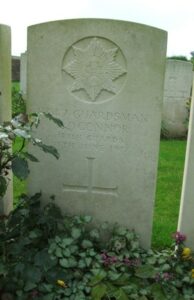
Sidney Ambrose Phelps, Corporal, 1888, Welsh Guards. Sidney was the son of Charles and Elizabeth Phelps, of 168, Cheltenham Road, Montpelier, Bristol. He served as a Policeman, PC 730, at Gowerton prior to the war. Sidney enlisted in Swansea into the Welsh Guards and was posted to France early in 1916, joining the 1st Battalion, Welsh Guards, which was in the Ypres Salient attached to the 3rd Guards Brigade, Guards Division. The Guards Division left for the Somme on 27 July 1916 in order to take part in the Somme offensive. On 9 September the Welsh Guards stood ready behind the 16th Division, which had been tasked with the capture of the village of Ginchy, ordered to take over the village once it had been captured. As the Welsh Guards advanced during the morning of 10 September they soon found that the village had not been cleared and their right flank was open to the enemy. The Germans took advantage of the situation and counter-attacked at dawn and fierce fighting raged throughout the day. The battalion was relieved on the following day and after a brief rest in billets moved back forwards on 14 September in order to take part in the next phase of the attack, against the line of Flers, Morval, and Lesboeufs. At dawn on 16 September the Welsh Guards attacked again, supported for the first time by tanks. Heavy rain blunted the attack which stalled some 100 yards short, with heavy losses among the battalion. The battalion was relieved during the night and did not go back into action until 22 September, when it moved back into the line, which was still stagnant in front of Lesboeufs and Morval. Preceded by a two-day bombardment, the attack was renewed at dawn on 25 September 1916. The advance proved a success, although the left flank of the battalion had difficulty in securing its positions for a while. Sidney was killed in action here on 25 September 1916, aged 30. He has no known grave and is commemorated on pier and face 7D of the Thiepval Memorial, France.
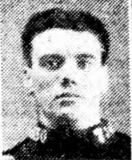
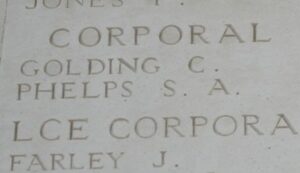
John Pope, Sergeant, 18097, Gloucestershire Regiment. John was born at Long Sutton, Somerset on 22 August 1888, the son of John and Mary Ann Pope. By 1911 he was serving as a Policeman, PC 51, at Bargoed. John married Lily May Tucker, at Bargoed, in the spring of 1915, before after enlisting at Cinderford into the 13th Battalion, Gloucestershire Regiment (Bristol’s Own). The battalion landed in France on 3 March 1916 as the Pioneer battalion to the 39th Division. On 30 June 1916 the division took part in a very costly attack in the area of Richebourg l’Avoue. It moved to the Somme in August 1916, where it fought at the Battle of the Ancre Heights, capturing the Schwaben Redoubt, and helped capture Regina Trench. It then fought at the Battle of the Ancre, and remained on the Somme over the winter. In 1917 the Division fought throughout the Third Battle of Ypres, before moving south to the St. Quentin sector. It was one of the divisions hit hard there following the German Spring offensive of 21 March 1918 and suffered terrible casualties during its withdrawal over the coming days. John was killed in action during this tumultuous period, on 25 March 1918, aged 29. He has no known grave and is commemorated on panels 40-41 of the Pozieres Memorial, France.
James Edwin Price, Lance Corporal, 6712, Cavalry. James was born in Much Marcle, Herefordshire, the son of James Edward Price and Flora Price. The family was living in 143, Broadway, Cardiff by 1901. James was a musician when he enlisted into the 18th (Queen Mary’s Own) Hussars on 21 April 1906, then left to become a policeman, PC 246, at Barry Docks. He re-enlisted into his old regiment following the outbreak of war and landed in France on 15 August 1914 as part of the 2nd Cavalry Brigade, 1st Cavalry Division of the BEF. The Hussars took part in the Battle of Mons and the retreat from Mons to the Marne, before moving to Flanders following the successful Battles of the Marne and Aisne. The 1st Cavalry Division moved to the area north of Bethune to help prevent a German break-through there, while other units of the BEF moved to defend the city of Ypres, and took part in the First Battle of Ypres, which began on 19 October 1914. By the morning of 1 November, the 18th Hussars were billeted around the village of Wulverghem, and were ordered to dismount and move forwards to support the KOYLI and 9th Lancers in the line at right angles to the Wulverghem to Messines road. Three battalions of German infantry were spotted advancing towards the Messines road, and the Dragoons intercepted them in conjunction with two companies of the KOYLI and forced the Germans to withdraw in disarray. James was killed in action during this engagement on 1 November 1914. The 23-year-old is buried in grave III.A.23. in Lille Southern Cemetery, France.
Alfred John Pugh, Private, 3260, Welsh Guards. Alfred was the son of George and Annie Maria Pugh, of 64, Lan Street, Morriston. He was a tinplate worker prior to becoming a Policeman, PC 292, at Mountain Ash prior to the war. He enlisted at Morriston into the Welsh Guards and was posted to the 2nd Battalion, Welsh Guards at the depot at Caterham. He did not serve overseas with the Welsh Guards, but became ill and died of meningitis on 17 February 1917, aged 21. Alfred is buried in grave A.6. in Orpington (All Saints) Churchyard Extension, Kent.
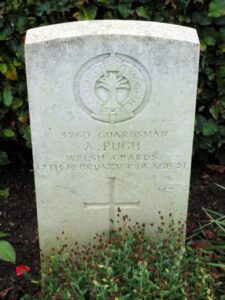
William Henry Radbourne, Lance Corporal, 19601, Coldstream Guards. William was the son of Henry Thomas Radbourne and Emily Radbourne, of 26, Victoria Road, Redhill, Surrey. He served as a Policeman, PC 732, at Llandaff prior to the war. William enlisted at Cardiff into the Coldstream Guards in October 1916 and was posted to France at some time in 1917, joining the 3rd Battalion, Coldstream Guards, which was attached to the 1st Guards Brigade, Guards Division. Following the cessation of the Third Battle of Ypres, where the Guards Division played a large part, it was moved south to take part in the forthcoming Cambrai offensive. The Guards were initially held in reserve for the opening of the battle on 20 November 1917, and did not go into action until the battle had turned in favour of the Germans, who launched a series of counter-attacks which created a salient around the village of Flesquières. After taking part in heavy fighting around Gouzeaucourt, the Guards Division was moved out for a rest on 27 November. Three days later, the Germans broke through the British lines and the Guards were rushed forwards and recaptured Gouzeaucourt with the support of tanks, preventing a German breakthrough. The Guards Division remained in the area over the winter, and on 8 January saw the breaking up of some of its battalions, due to the re-organising of the structure of divisions within the BEF. As a result, the 3rd Battalion, Coldstream Guards transferred to the 4th Guards Brigade, 31st Division on 4 February 1918. The division was south of the Guards Division and was amongst those units hit hard by the German spring offensive, which was launched on 21 March 1918. William was wounded during the terrible fighting which followed and died of his wounds at the 9th Field Ambulance, on 26 March 1918, aged 23. He was originally buried in Blairville Orchard British Cemetery, just south-west of Arras, but in July 1923 the graves in the cemetery were exhumed and relocated in Cabaret-Rouge British Cemetery, Souchez, France. William now lies in grave VIII. R. 45.
Ernest Lewis Reeves, Guardsman, 1279, Welsh Guards. Ernest was the son of William and Sarah Annie Reeves, of 3, Dogfield Street, Cathays, Cardiff. Following the death of his father in 1909, Ernest moved to Abercynon where he worked as a steam engine attendant. He became a Policeman, PC 364, at Penarth prior to the war. Ernest enlisted at Cardiff into the 1st Battalion, Welsh Guards. The Regiment was raised by Royal Warrant of 26 February 1915, at White City, before landing at Le Havre on 18 August 1915, becoming attached to 3rd Guards Brigade, Guards Division. The Division saw its first major action during the Battle of Loos on 25 September 1915. The Guards Division was in reserve for the first two days of the battle, before moving forwards on the night of 26-27 September to take part in an assault on Hill 70, a feature which overlooked Loos village. The attack was carried out during the night of 27 September, but saw the Welsh Guards driven back after suffering heavy casualties. Ernest was killed during this assault on Hill 70 on 27 September 1915. The 21-year-old has no known grave and is commemorated on panel 10 of the Loos Memorial, France.
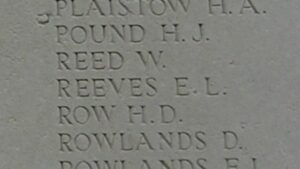
Frederick Richards, Corporal, 13027, South Wales Borderers. Frederick was the son of Edgar George and Emily Richards, of 4, Romilly Crescent, Canton, Cardiff. He worked for his father’s fruit and vegetable business prior to becoming as a Policeman, PC 134, at Ogmore Vale prior to the war. Frederick enlisted at Bridgend into the 4th Battalion, South Wales Borderers following the outbreak of war. The battalion was attached to 40 Brigade, 13th (Western) Division, and embarked from Avonmouth for Gallipoli on 29 June 1915, landing at Gallipoli on 15 July 1915 to relieve the 29th Division. The 13th Division left and returned to Mudros at the end of the month, before landing at ANZAC Cove from 3 August 1915, in order to take part in a renewed offensive alongside the Anzacs. During the evening of 6 August 1915, the 4th SWB led the advance of the division and by the early hours of 7 August 1915 had secured their objective on Damakjelik Bair. Frederick was killed in action during the attack that morning. The 30-year-old has no known grave and is commemorated on panels 80-84 of the Helles Memorial, Gallipoli.
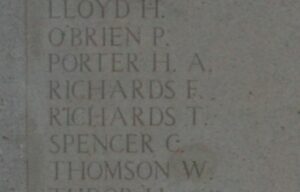
Edward Shurey, Lieutenant, Welsh Regiment. Edward was born on 16 September 1891, the son of Harry and Charlotte Shurey, of 17, William Street, Ystrad Rhondda. He served as a Policeman, PC 616, at Whitchurch prior to the war. Edward was commissioned into the 16th Battalion, Welsh Regiment on 16 March 1915 and in April 1916 joined the battalion at Laventie in northern France, where it was learning the arts of trench warfare with the 38th (Welsh) Division. On 6 May 1916, Edward was attending a grenade school, when a rifle grenade exploded, injuring him and eight men. He married Florence Mary Pritchard, of Meadow View, Leam Terrace, Leamington Spa at St. Asaph whilst on leave in 1917, prior to being posted to Southern Ireland. Edward seems to have been very unfortunate with hand grenades, as he was accidentally killed while training with hand grenades in the Curragh Camp on 18 July 1918, aged 27. He is buried in Curragh Military Cemetery, Ireland. He is also remembered on a Remembrance Plaque at The Royal Alexandra Hospital, Rhyl; and on The North Wales Heroes Memorial Arch, Bangor.
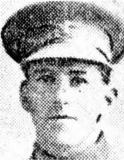
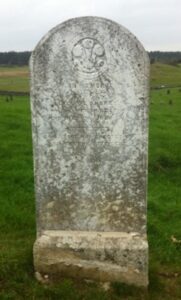
Frederick George Smith, Private, S/20038, Argyll and Sutherland Highlanders. Frederick was the son of John Sidney Smith and Eliza Ann Smith, of 31, Beauchamp Street, Riverside, Cardiff. He served as a Policeman, PC 692, at Taibach prior to the war. He originally enlisted on 22 September 1915 into the Royal Army Medical Corps, and was posted to Kantara, in Egypt, joining the 1/1st Lowland Field Ambulance and served in the Palestinian campaign before being hospitalised after falling ill. On 8 March 1918 Frederick volunteered to transfer to the 12th Battalion, Argyll & Sutherland Highlanders, which was in Salonika attached to 77 Brigade, 26th Division. The Allies had been in stalemate against the Bulgarian First Army on the River Doiran since 1916, and were planning for a large-scale offensive to drive the Bulgarians out of Greece. The 26th Division was to attack alongside the 22nd Division and capture Pip Ridge, alongside a Greek Division. The battle was launched on 18 September 1918, and initially the Allies made some gains, but a Bulgarian counter-attack coupled with heavy artillery fire forced them to withdraw. The Allies attacked again on the following morning, but were met with the same result. Frederick was killed in action during this second assault, on 19 September 1918, aged 28. He is buried in grave V.F.14. in Doiran Military Cemetery, Greece. Several days afterwards, the Bulgarians withdrew and on 30 September 1918 surrendered.
Charles Henry Snailham, Serjeant, 15156, Grenadier Guards. Charles was born on 22 February 1893, the son of Charles and Sarah Snailham, of 11, Hankey Terrace, Merthyr Tydfil. He had worked for the GWR at Merthyr prior to joining the Grenadier Guards in March 1911. After two years with the colours, Charles left the army to become a Policeman, PC 622, at Aberdare prior to the war. He had been a policeman for less than a year when war broke out and he re-joined the Grenadier Guards on 4 August 1914. He was posted to the 3rd Battalion, Grenadier Guards and landed in France with the battalion on 26 July 1915, where it became attached to the 2nd Guards Brigade, Guards Division. The division moved into the Loos area in order to take part in the forthcoming Battle of Loos, which opened on 25 September 1915. The Guards moved into their positions on the night of 26-27 September in order to attack a and capture a strong German position known as Hill 70, which overlooked Loos village. The 1st Guards Brigade would hold the left flank opposite Hulluch; 2nd Guards Brigade would advance through Bois Hugo and Chalet Wood and then attack Hill 70 from the north whilst the 3rd Guards Brigade attacked it from the west. The attack on Hill 70 was beaten off by the Germans, with the Welsh Guards especially suffering terrible casualties from machine-gun fire. The 3rd Battalion, Grenadier Guards, supporting the Scots Guards, assaulted Puits 14, a coal mine, but also came under heavy fire and failed to reach their objectives. Charles was killed when a shell exploded in front of him on 27 September 1915. A contemporary newspaper report stated he had merely been wounded by the shell, but this was incorrect. The 23-year-old has no known grave and is commemorated on panels 5-7 of the Loos Memorial, France.

William Syphas, Acting Bombardier, 21519, Royal Garrison Artillery. William was the son of Daniel and Edith Jane Syphas, of Chipping Norton. He served as a Policeman, PC 293, at Pentre and at Ystalyfera prior to the war. William was an army reservist, and re-enlisted at Devizes into the Royal Garrison Artillery. He was posted to France, joining the 56th Siege Battery, Royal Garrison Artillery which was in the Ypres sector, part of a massive artillery force which was bombarding German positions in readiness for the forthcoming offensive, known as the Third Battle of Ypres. William was killed in action at Ypres on 24 July 1917, most likely by counter-battery fire from the Germans. The 34-year-old is buried in grave II.E. 19. In Dickebusch New Military Cemetery Extension, Belgium.
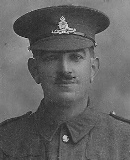
David Taffinder, Serjeant, 23117, Welsh Regiment. David was the son of William and Sarah Jane Taffinder, of Cowbridge Road, Cardiff. He served as a Policeman, PC 760, at Maesteg prior to the war. David enlisted at Bridgend into the 16th Battalion, Welsh Regiment (Cardiff City), which was training at Rhyl and moved with the battalion, which was attached to 115 Brigade, 38th (Welsh) Division, to Winchester in the summer of 1915. During his time training at Rhyl he became champion bayonet fighter within the 16th Welsh. On 4 December 1915 David landed in France with the battalion, and the entire 38th (Welsh) Division moved to the Nursery Area around Fleurbaix for trench initiation. During the beginning of February 1916, the 16th Welsh held positions near Croix Barbee, before moving to billets at Locon on 17 February. On 19 February the 16th Welsh moved back into the front line for another tour of duty, taking up positions known to the troops as islands, isolated outposts built up around the sodden battlefield. David was on patrol in the early hours of 20 February 1916 when he was hot twice by bullets from German snipers. Badly wounded he was carried to a dressing station where he died that same day, aged 22. David is buried in grave III.D.17. in Le Touret Military Cemetery, Richebourg L’Avoue, France.
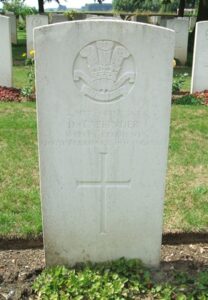
Edward John Taylor, Lance Corporal, 1385, Welsh Guards. Edward was the son of George and Susan Taylor, of Kinsey Cottage, Llanvihangel-Gobion, Abergavenny. He worked as a waggoner on his brothers farm prior to becoming a Policeman, PC 62, at Maesteg prior to the war. He enlisted at Bridgend into the 1st Battalion, Welsh Guards. The Regiment was raised by Royal Warrant of 26 February 1915, at White City, before landing at Le Havre on 18 August 1915, becoming attached to 3rd Guards Brigade, Guards Division. The Division saw its first major action during the Battle of Loos on 25 September 1915. The Guards Division was in reserve for the first two days of the battle, before moving forwards on the night of 26-27 September to take part in an assault on Hill 70, a feature which overlooked Loos village. The attack was carried out during the night of 27 September, but saw the Welsh Guards driven back after suffering heavy casualties. After a few days rest the Welsh Guards went back into action slightly to the north, at the Hohenzollern Redoubt and remained here until being relieved on 27 October, moving to the Ypres Salient. On 31 April 1916 the Welsh Guards moved from a rest camp at Poperinghe to the front line at Potijze. After two days in the line the battalion marched to Vlamertinghe, and after another rest spell, moved back to Potijze on 6 May, while Ypres was being heavily shelled. On 8 May 1916 a strong patrol was sent out under Lieutenants Battye and Crawshay and engaged the Germans in their own trench until returning after suffering seven casualties. Edward was one of two men killed in the raid. The 24-year-old is buried in grave B.4. in Potijze Burial Ground Cemetery, Belgium.
Edward John Richard Thomas, Company Sergeant Major, 24093, Welsh Regiment. Edward, known as Richard, was the born in Ferndale on 14 October 1880, the son of Joseph and Mary Ann Thomas. He was the husband of Alice B. Thomas and the couple had two children. Richard was a renowned rugby player, having played for Mountain Ash, Bridgend, Cardiff and Glamorgan, and represented Wales at forward several times prior to the war. He served as a Policeman, PC 200, at Bridgend prior to the war. Richard enlisted into the 16th Battalion, Welsh Regiment (Cardiff City) early in 1915. The battalion trained at Rhyl and Winchester as part of 115 Brigade, 38th (Welsh) Division, before landing in France on 4 December 1915. The division moved to the Nursery Sector at Fleurbaix for trench initiation alongside the 19th Division, and held several sectors from there down to Cuinchy before marching south in June 1916 in order to take part in the forthcoming Somme offensive. It relieved the 7th Division in the line south of Mametz Wood, and on 7 July the division launched its first assault on the wood, sending in the 11th SWB and 16th Welsh of 115 Brigade. Heavy machine-gun fire decimated the two battalions who were reinforced by the 10th SWB, but this initial attack was doomed to failure because of inadequate artillery support and lack of smoke screen. The 16th Welsh alone had suffered the loss of six officers and 131 men killed, six officers and 138 men wounded during the day, almost eliminating what was a fine unit. Richard was among the dead, one of three CSM’s killed. The 35-year-old has no known grave and is commemorated on pier and face 7A and 10A of the Thiepval Memorial, France.

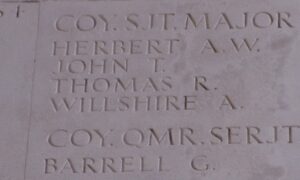
Thomas Thomas, Corporal, 32796, Welsh Regiment. Thomas was the son of William and Elizabeth Thomas, of 37, Friars Road, Bangor. He worked in a slate quarry prior to moving to south Wales and served as a Policeman, PC 535, at Mumbles prior to the war. He enlisted in Swansea into the Welsh Regiment and was posted to the 16th Battalion, Welsh Regiment (Cardiff City), which was attached to 115 Brigade, 38th (Welsh) Division. On 4 December 1915 the battalion moved to France, and the entire Division moved to the Fleurbaix sector, where it was initiated into trench warfare. During June 1916 the Division marched south to the Somme, and on 7 July 1916 115 Brigade attacked Mametz Wood. The initial attack failed, almost decimating the two attacking battalions, the 11th SWB and the 16th Welsh, so the 10th SWB were sent into bolster the assault, but after suffering heavily the three decimated battalions were forced to retire. What was seen as a failure by the division caused the sacking of Sir Ivor Philipps, the divisional commander, and with new leadership three days later, on 10 July, a fresh attack was mounted. After two days of heavy hand to hand fighting within the wood, the Germans withdrew, and the battered Welshmen moved via Hébuterne to Boesinghe, on the Yser Canal, where it remained until launching its attack on Pilckem Ridge on 31 July 1917. Following the successful capture of its objectives, the division played a supporting role in the ensuing Battle of Langemarck before being relieved and posted to the quieter Armentieres sector for the winter. On 19 November 1917 the 16th Welsh was in the line in the Houplines sub-sector when it came under heavy artillery fire from both German artillery and trench mortars. Thomas was killed in action during the barrage that day. The 23-year-old is buried in grave II.A.1. in Cite Bonjean Military Cemetery, Armentieres, France.
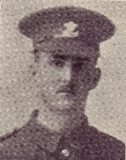
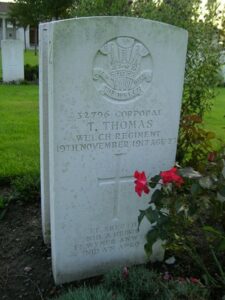
William John Thomas, Serjeant, 11848, Grenadier Guards. William was the son of William Thomas, of Maindy. He served as a Policeman, PC 609, at Port Talbot prior to the war. William was an army reservist and re-joined his old regiment, the Grenadier Guards, at Cardiff in August 1914. He embarked for France with the 2nd Battalion, Grenadier Guards on 13 August 1914 and took part in the Battle of Mons and the epic retreat south to the Marne, attached to the 2nd Division. Following the successful Battles of the Marne and Aisne, which stopped the German drive on Paris, at the beginning of October the BEF was moved north to Flanders, taking up positions from Poelcapelle, east of Ypres, down as far as Béthune. On 21 October the Germans launched an assault towards Ypres, known as the Battle of Langemarck, which was the opening battle of the First Battle of Ypres. Despite suffering terrible casualties, the BEF stood firm, so on 28 October the Germans switched the focus of their attacks along the Menin Road towards Gheluveld. Desperate fighting by the 2nd Welsh and 1st SWB, assisted by an attack by the Worcester’s, prevented a breakthrough on 31 October. Meanwhile the 2nd Division supported a French attack towards Roulers and Thourout, north-east of Ypres. William was killed when he was shot by a sniper here on 4 November 1914. He has no known grave and is commemorated on panels 9-11 of the Ypres (Menin Gate) Memorial, Belgium.
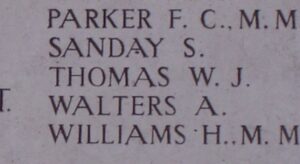
William Jones Thomas, Guardsman, 1333, Welsh Guards. William was the son of John and Ann Thomas, of Pantglas Farm, Llanedeyrn. He served as a Policeman, PC 319, at Porthcawl prior to the war. He enlisted at Bridgend into the 1st Battalion, Welsh Guards following its formation by Royal Warrant of 26 February 1915. The newly formed regiment had the honour of being on guard at Buckingham Palace on St David’s Day, 1915. The 1st Battalion, Welsh Guards landed at Le Havre on 18 August 1915, becoming attached to 3rd Guards Brigade, Guards Division. The Division saw its first major action during the Battle of Loos on 25 September 1915, seeing very heavy fighting around Hill 70 on the 27th. The Guards Division wintered in the Ypres Salient before leaving for the Somme on 27 July 1916 in order to take part in the Somme offensive. On 9 September the Welsh Guards stood ready behind the 16th Division, which had been tasked with the capture of the village of Ginchy, ordered to take over the village once it had been captured. As the Welsh Guards advanced during the morning of 10 September they soon found that the village had not been cleared and their right flank was open to the enemy. The Germans took advantage of the situation and counter-attacked at dawn and fierce fighting raged throughout the day. The battalion was relieved on the following day and after a brief rest in billets moved back forwards on 14 September in order to take part in the next phase of the attack, against the line of Flers, Morval, and Lesboeufs. At dawn on 16 September the Welsh Guards attacked again, supported for the first time by tanks. Heavy rain blunted the attack which stalled some 100 yards short, with heavy losses among the battalion. Following further fighting on the Somme, the Welsh Guards wintered there, and followed up the German withdrawal to the Hindenburg Line the following spring. At some time during the early months of 1917 William took ill and was invalided home. He died of trench fever and trench feet in hospital in London on 13 April 1917, aged 29, and is buried in Llanedeyrn Churchyard, Glamorgan, south of the Church tower.
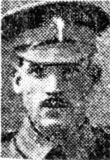
William Edward Trinder, Lance Corporal, 32681, Welsh Regiment. William was the son of John James Trinder and Joanna Trinder, of Winstone, Cirencester. He served as a Policeman, PC 89, at Caerau for eight years prior to enlisting into the Welsh Regiment in 1915. He was posted to the 16th Battalion, Welsh Regiment (Cardiff City), which was in training at Rhyl attached to 115 Brigade, 38th (Welsh) Division, and landed in France with the battalion on 4 December 1916. The division moved to the Nursery Sector at Fleurbaix for trench initiation alongside the 19th Division, and held several sectors from there down to Cuinchy before marching south in June 1916 in order to take part in the forthcoming Somme offensive. It relieved the 7th Division in the line south of Mametz Wood, and on 7 July the division launched its first assault on the wood, sending in the 11th SWB and 16th Welsh of 115 Brigade. Heavy machine-gun fire decimated the two battalions who were reinforced by the 10th SWB, but this initial attack was doomed to failure because of inadequate artillery support and lack of smoke screen. The 16th Welsh alone had suffered the loss of six officers and 131 men killed, six officers and 138 men wounded during the day, almost eliminating what was a fine unit. William was among those killed that day. The 30-year-old has no known grave and is commemorated on pier and face 7A and 10A of the Thiepval Memorial, France.
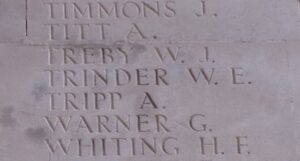
Sidney Walter Williams, Gunner, 180142, Royal Garrison Artillery. Sidney was the son of Thomas and Mary Williams, of Castle Coch Cottage, Magor, Newport. He served as a Policeman, PC 696, at Ton Pentre prior to the war. He enlisted at Pentre into the Royal Garrison Artillery and was posted to France to join the 326th Siege Battery, Royal Garrison Artillery. The battery was in the Loos sector during the summer of 1918 when Sidney was wounded. He died of his wounds at the 73rd Field Ambulance on 21 July 1918, aged 22 and is buried in grave V.G.8. in Bully-Grenay Communal Cemetery, British Extension, France.
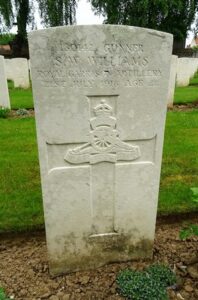
William James Williams, Lance Corporal, 1101, Welsh Guards. William was the son of Richard and Catherine Williams, of Llantrisant and the husband of Emily Williams, of Abercynon. He served as a Policeman, PC 225, at Heolycyw prior to the war. William enlisted at Bridgend into the Dragoon Guards, and transferred to the 1st Battalion, Welsh Guards following its formation by Royal Warrant of 26 February 1915. The newly formed regiment had the honour of being on guard at Buckingham Palace on St David’s Day, 1915. The 1st Battalion, Welsh Guards landed at Le Havre on 18 August 1915, becoming attached to 3rd Guards Brigade, Guards Division. The Division saw its first major action during the Battle of Loos on 25 September 1915, seeing very heavy fighting around Hill 70 on the 27th. The Guards Division wintered in the Ypres Salient, and spent several months in the Potijze sector. On 1 July 1916, the Welsh Guards were in the line at La Belle Alliance and mounted a raid on the Mortjelde Estaminet, a strongly held German post. The raid was a success, but Second Lieutenant Crawford Wood and five men were killed. William was among the dead. The 29-year-old is buried in grave II.F.11. in Brandhoek Military Cemetery, Belgium.
